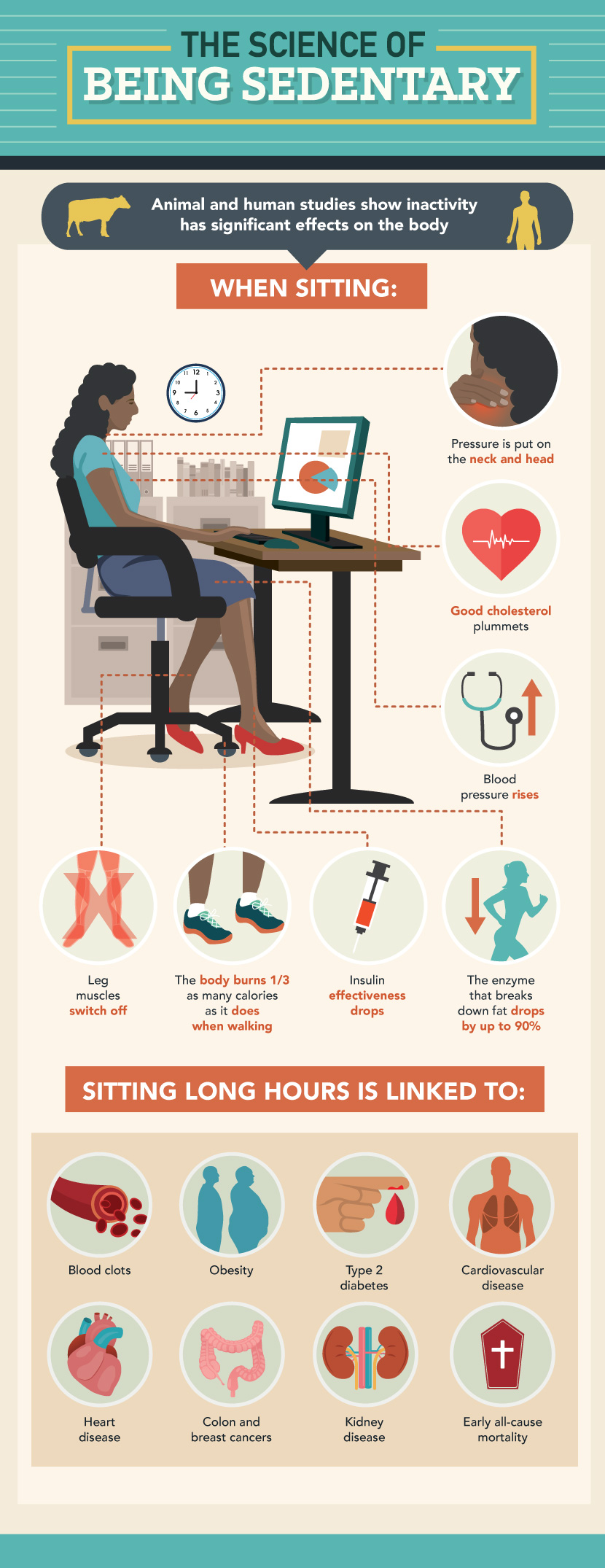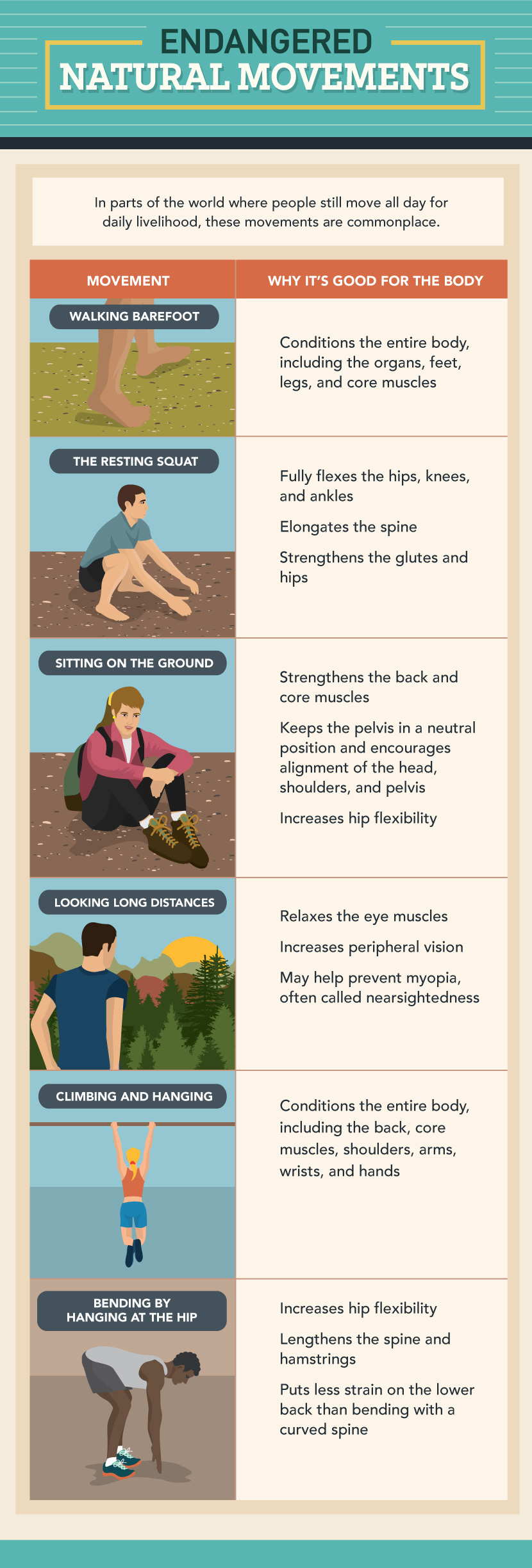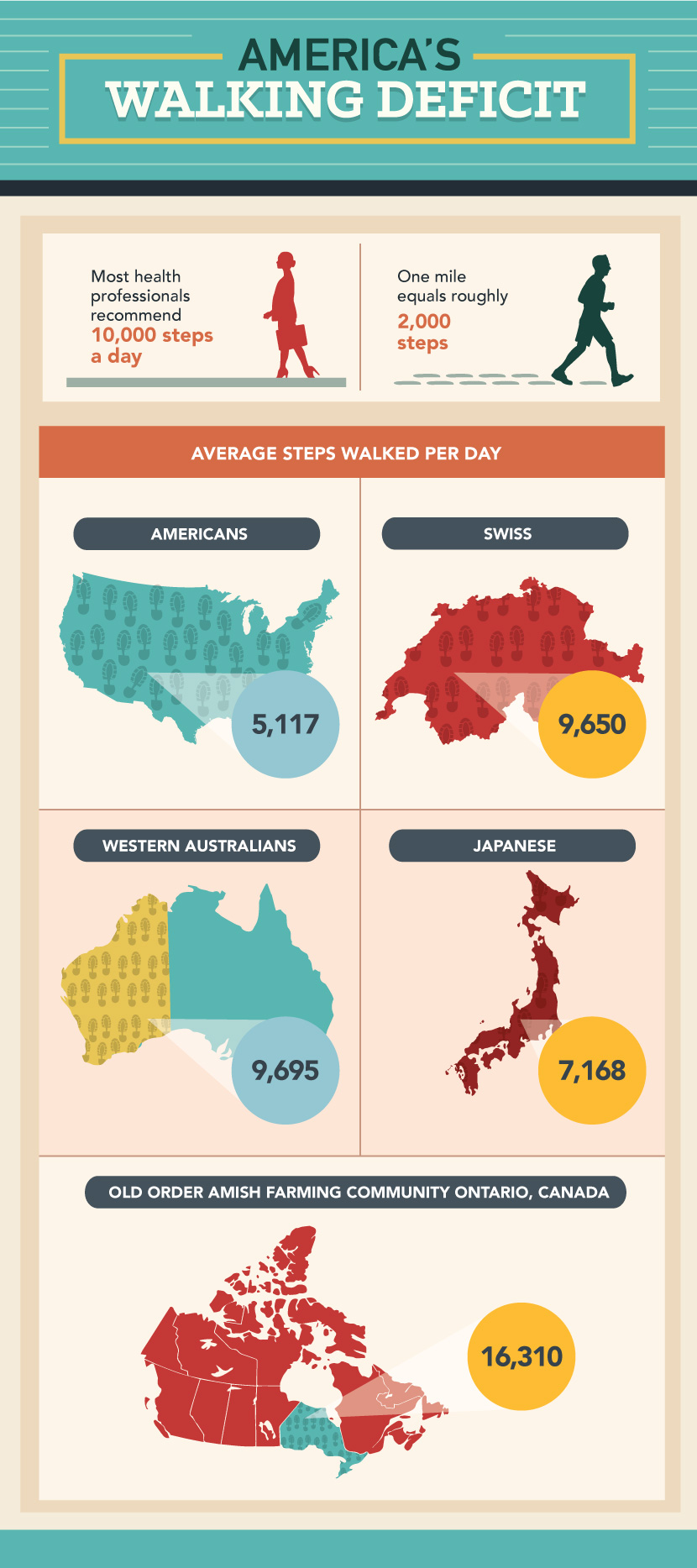Make a Move
Natural Movement for Optimal Health
Americans sit a lot. Between the car, desk, and couch, most adults are in a chair for 13 hours a day, http://www.prnewswire.com/news-releases/new-survey-to-sit-or-stand-almost-70-of-full-time-american-workers-hate-sitting-but-they-do-it-all-day-every-day-215804771.html and our kids are less active than they’ve ever been. http://www.npr.org/sections/health-shots/2013/11/20/246316731/kids-are-less-fit-today-than-you-were-back-then http://www.ncbi.nlm.nih.gov/pubmed/18091006 For a long time, health experts prescribed regular bouts of exercise to counteract our otherwise sedentary ways. But a growing body of research suggests exercising several times a week is not the real solution.
First of all, 80 to 95 percent of adults don’t actually get the two and a half hours of moderate aerobic exercise or 75 minutes of vigorous exercise per week recommended by the government. http://www.cbsnews.com/news/cdc-80-percent-of-american-adults-dont-get-recommended-exercise/ http://www.ncbi.nlm.nih.gov/pubmed/18091006 More alarmingly, those who do are still at risk for health problems if they’re inactive for long periods during the rest of the week. http://www.runnersworld.com/sweat-science/does-sitting-really-cancel-the-benefits-of-exercise
Our bodies are not designed to be sedentary. http://www.latimes.com/science/sciencenow/la-sci-sn-get-up-20140731-story.html All people – fitness buffs or not – need to get more of the varied, all-day movement that was naturally part of daily life for people of past generations. Read on for ways to incorporate more movement into daily life.

Exercise Versus Movement
Many people think of exercise and movement as the same thing, but it’s helpful to distinguish between the two. Exercise comprises the activities people do for the purpose of getting fit, such as going for a run or lifting weights at the gym. Movement includes not only exercise, but all the other activities people do as a part of daily life as well, such as washing the floor, mowing the lawn, and making dinner. A walk could be exercise or just movement; the difference is the intention behind it. If someone straps on a heart-rate monitor and strides around a track for a workout, that’s exercise. If the same person walks to the post office to mail a letter, that’s movement.
Exercise is not new. The ancient Chinese, Indians, and Greeks all developed physical fitness regimens that are still around today. https://www.unm.edu/~lkravitz/Article%20folder/history.html But for most of history, people also moved a lot as part of daily life. Retrieving water, finding and growing food, cleaning the house, and washing clothes required all-body movement. However, with cars and labor-saving devices, many of us move little these days, except when we exercise.
The Magic of Movement
Public health experts put a lot of emphasis on exercise. But how much we move, rather than how much we exercise, is an often-overlooked indicator of good health. Mayo Clinic researcher Dr. James Levine studies the energy people expend doing activities other than exercise, a category he calls Non-Exercise Activity Thermogenesis (NEAT). He’s consistently found that people who expend more energy by moving around, even just by walking to the restroom or fidgeting, are thinner and healthier regardless of whether they also exercise. http://atvb.ahajournals.org/content/26/4/729.full Moreover, in a nine-country European breast cancer study, of all the activities and exercise in which women partook, household activity – including housework, home repair, gardening, and stair climbing – was the only activity shown to significantly reduce breast cancer risk, not exercise. http://cebp.aacrjournals.org/content/16/1/36.full Another study found that people who fidget a lot do not suffer the same morbidity risks from sitting as people who rarely fidget. http://www.ajpmonline.org/article/S0749-3797%2815%2900345-1/abstract These studies suggest that an increase in non-exercise movement can benefit overall health.
If you love exercise as it is, keep it up. It can be great for you, especially if it makes you feel good. Just remember that a bout of exercise does not replace all-day movement. In fact, sometimes workouts have a way of making people more sedentary for the rest of the day. In a small study conducted by the American College of Sports Medicine at Illinois State University, people were about 30 percent less active overall on days when they exercised. http://journals.lww.com/acsm-msse/Fulltext/2013/05001/B_29_Free_Communication_Poster___Fitness_and_the.39.aspx In another study, marathoners were dubbed “active couch potatoes” because they were highly sedentary when they weren’t running, sitting an average of eight to 10.75 hours a day. http://www.ncbi.nlm.nih.gov/pubmed/23357808
If you don’t exercise often, you’re not alone. But rather than focus only on the half hour of the day we’re supposed to engage in moderate exercise, consider what you do for the other 15 and a half hours you’re awake. Biomechanist Katy Bowman explains that we’ve long thought that some daily exercise could stand in for the varied, all-day movement our ancestors got, just as many people thought supplements could essentially replace healthy food. Bowman, Katy, Move Your DNA; Gokhale, Esther, 8 Steps to a Pain Free Back; Porter, Kathleen, Natural Posture for Pain Free Living However, both assumptions are wrong. “You don’t really need exercise to stay healthy, you need movement to stay healthy,” she says. How do you get more of it? It’s not as arduous as you may think.

A Movement Makeover
A key way to fit more movement into a busy lifestyle is to add movement to activities you already do. Feeling better is a great side effect and incentive. The following tactics can encourage more daily movement.
Leave the Car at Home
Walking is the superfood of movement, according to many health experts. We were built to do it, and it requires no equipment. It is the anti-sit, and the health benefits of doing more of it are endless. It conditions the entire body and it can help ward off various ailments, including heart disease and some types of cancer. http://www.realsimple.com/health/fitness-exercise/benefits-walking/walking-9
If possible, replace car trips with walks to incorporate more movement into your day. You’ll also enjoy the added benefit of arriving to your destination feeling clear-headed and relaxed. http://www.dailymail.co.uk/health/article-2356004/You-CAN-walk-away-stress-Scientists-discover-stroll-soothe-brain.html If walking the full route to work, school, or on errands is too much, ease into it by parking further away. If walking isn’t an option, try biking or taking public transportation. A British study found public transit riders were the healthiest of all the commuters studied, possibly because they ended up walking most. http://www.sciencetimes.com/articles/7672/20151111/bus-train-commuters-healthier-walkers-bikers.htm
Dress for Movement
Style may be important, but so is breathing, digesting food, and allowing the lymph system, circulatory system, and joints to do their jobs. Foot binding and Victorian corsets are extreme examples of how historical garment choices affected the body’s functions. Today’s tight, restrictive clothes also take a toll. https://www.ndhealthfacts.org/wiki/Clothing_and_Shoes When possible, wear loose-fitting, comfortable clothing that lets your body move freely.
Switch Your Shoes
Our feet contain 33 joints and more than 100 muscles, tendons, and ligaments, and they’re designed to work barefoot. Shoes, especially those with a heel, can injure feet and ankles and lead to chronic pain. One study compared the feet of 180 modern shoe-wearing humans to prehistoric skeletal remains and found barefoot populations had much healthier feet. http://www.thefootjournal.com/article/S0958-2592%2807%2900053-3/abstract
Heeled shoes don’t just hurt the feet; they throw off the body’s alignment and can lead to pain in other parts of the body. http://www.functionalps.com/blog/2012/12/20/high-heeled-shoes-a-real-pain/ Women’s pumps and stilettos aren’t the only culprits. Most running shoes, men’s dress shoes, and custom orthotics have a heel. Regularly go barefoot in the house or office to allow feet their full range of motion, and walk barefoot outside for even more health benefits. http://www.ncbi.nlm.nih.gov/pmc/articles/PMC3265077/
Also consider transitioning to less supportive or so-called minimalist shoes. http://www.drnicksrunningblog.com/new-study-demonstrates-barefoot-walking-and-minimalist-shoe-gear-reduces-knee-pain-due-to-osteoarthritis-2/ Shoes with a minimal heel or no heel support the body’s natural alignment and help feet get and stay strong and supple. A wide toe base allows foot muscles and joints more mobility. http://drtheresa.com/article/walk-barefoot-minimalist-shoes Just be sure to transition into less supportive shoes gradually to prevent foot injuries.
Sit on the Floor
If you can get up off the floor without using a hand or knee for support, you’re probably in good shape. This simple test has been shown to predict longevity in older adults. http://www.escardio.org/The-ESC/Press-Office/Press-releases/Last-5-years/Ability-to-sit-and-rise-from-the-floor-is-closely-correlated-with-all-cause-mort Sitting on the floor builds strong back and core muscles, increases hip flexibility, and encourages people to change positions more often. (Anthropologist Gordon Hewes documented dozens of positions traditional people used to rest on the ground.) http://nutritiousmovement.com/your-position-in-life/ http://www.jstor.org/stable/666393?seq=1#page_scan_tab_contents Although there’s not much research on the matter, it’s probably no coincidence that in countries where people sit on the floor regularly, they also tend to stay mobile into old age. We all need to sit at times to work, eat, and rest. Try doing some of that sitting on the floor.
Vary Your Work Positions
Standing desks have become popular, but factory workers know standing all day can be as hard on the body as sitting all day. It’s best to vary work positions. http://healthland.time.com/2011/04/13/the-dangers-of-sitting-at-work%E2%80%94and-standing/ Moving a laptop to different surfaces is easiest for telecommuters, who won’t feel as silly sitting on the floor or standing in front of a bookshelf. Fortunately, many office managers are getting the message that a more active workforce can be a more productive one. http://www.pbs.org/newshour/making-sense/secret-improving-health-productivity-work/ Perhaps you already work in a movement-friendly office. But if you don’t, consider asking your boss or human resources department to invest in a dynamic work station, or fashion one yourself. http://healthymoving.com/podcast/episode-28-the-dynamic-workstation/ Regardless of what your desk looks like, get up and move often. Some experts advise moving for at least two minutes of every hour, and more is better.http://www.webmd.com/fitness-exercise/20150430/2-minute-walk-every-hour-may-help-offset-effects-of-sitting
Take phone calls or have meetings while walking. Go outside and look at the horizon or frequently look out the window to allow eye muscles to relax.

Every dog owner knows how important daily movement is for a canine’s well-being. Skip a few walks, and most hounds get irritable and stir-crazy. Humans have the same essential need for movement. Unfortunately, we often ignore our body’s natural cues to get active. Commit to more daily movement and reap countless benefits, including improved health, mobility, and vitality.
Embed the article on your site

